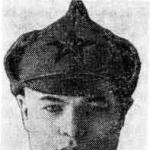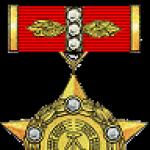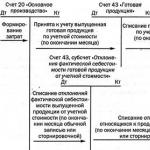In 1930, Amur became a training ship for the Leningrad Osoaviakhim team. On board, the future Heroes of the Soviet Union, submarine commander Evgeny Osipov, minesweeper boat commander Ivan Larin, and torpedo bomber pilot Nikolai Afanasyev, became involved in naval affairs.
Before the war, the Amur was again drafted into the navy and became a floating base for boats. Sunk on August 28, 1941 to block access for Nazi ships to Tallinn harbor.
Commissioned in 1909. Displacement - 2926 tons, length - 91.4 m, width - 14.0 m, depth - 4.4 m. Machine power - 5000 liters. With. Speed - 17 knots. Cruising range - 3200 miles. Armament: 5 - 120 mm, 2 - 75 mm guns, 8 machine guns, 324 mines. Crew - 322 people.
"Zabiyaka", destroyer.
The destroyer arrived from Helsingfors (now Helsinki in Finland) to Petrograd two hours before the assault on Winter Palace. He landed troops on the Neva embankment - 135 armed sailors. At the suggestion of the Bolsheviks, a detachment was formed from the ship’s crew, and G.I. Levchenko, the future deputy people’s commissar of the USSR Navy, was appointed commander.
The detachment with "Zabiyaki" was one of the first to break into the Winter Palace.
On November 1, by order of the Naval Revolutionary Committee, he went up the Neva and stood near the village. Rybatsky to protect access roads to the capital.
In 1919, the Zabiyaki sailors took part in the defense of Petrograd from the White Guard hordes of General Yudenich.
In December 1922, in memory of the fiery revolutionaries. S. Uritsky, who was killed by the Social Revolutionaries in Petrograd in 1918, the ship received the name “Uritsky”.
In August 1933, the destroyer made a passage along the White Sea-Baltic Canal to the north. During the Great Patriotic War, he traveled about 70 thousand miles while participating in battles, escorted 370 transports, and repelled 115 attacks from aircraft and submarines.
The veteran of the ship, Admiral Gordey Ivanovich Levchenko, also visited it on one of the trips.
Commissioned in 1915. Displacement - 1260 tons, length - 98.0 m, width - 9.3 m, depth - 3.0 m. Engine power - 30,000 liters. With. Speed - 35 knots. Cruising range - 2800 miles. Armament: 4 - 102 mm, 1 - 40 mm anti-aircraft gun, 2 machine guns, 3 three-tube torpedo tubes, 80 min. Crew - 150 people.
"Samson", destroyer.
In the October days of the seventeenth year, the ship was in Helsingfors for repairs. On the evening of October 24, the Samson received an order from Tsentrobalt: to go to the capital to help the Petrograd Soviet. The officers protested: the mechanisms were dismantled, the destroyer was not ready for sailing.
- “Samson” will fulfill his duty to the revolution! - said the ship committee.
During the night, the sailors did what the officers considered impossible: they put the machines into operation. 130 armed paratroopers boarded the Samson, and the ship headed for St. Petersburg. The banner “All power to the Soviets!” fluttered between the masts.
Entering the Neva, the destroyer aimed its guns at Zimny. The paratroopers and part of the team went to help the revolutionary troops. And three sailors, led by the Bolshevik Georgy Borisov, went to Smolny. They handed over a letter from Tsentrobalt to the presidium of the Second All-Russian Congress of Soviets. On behalf of one hundred thousand sailors, Centrobalt declared that the Baltic Fleet would “support the Congress’s struggle for power with all its armed forces.”
Among the participants in the assault on the Winter Palace was a sailor from the Samson, Vasily Kuprevich, later an outstanding Soviet botanist, academician and president of the Academy of Sciences of the Belarusian SSR, Hero of Socialist Labor.
After the Civil War, the destroyer received the name "Stalin". In 1936, he crossed the Northern Sea Route to Vladivostok. In 1945 he took part in the war with imperialist Japan.
Commissioned in 1916. Displacement - 1260 tons, length - 98.0 m, width - 9.3 m, depth - 3.0 m. Engine power - 30,000 l. With. Speed - 35 knots. Cruising range - 2800 miles. Armament: 4 - 102 mm, 1 - 40 mm anti-aircraft gun, 2 machine guns, 3 three-tube torpedo tubes, 80 min. Crew - 150 people.
"Faithful", training ship.
“There is an uprising in Petrograd,” the Kronstadt Soviet reported to the training ship Verny, stationed in Biorka, south of Vyborg. “It is proposed to urgently go to the capital and support the workers...”
Two companies of sailors from the artillery training detachment boarded the ship. On October 25 at 12:20 p.m., “Verny” headed for St. Petersburg. The ship's counter-revolutionary commander and several Socialist Revolutionaries tried, under various pretexts, to detain the Verny on its way, but the sailors, led by the Bolshevik Fyodor Kuznetsov-Lomakin, broke the resistance of the enemies of the revolution. At 20:15, “Verny” entered the Neva and stood at the embankment of Vasilyevsky Island. A landing party of sailors from the ship stormed the Winter Palace.
In 1924, the ship was renamed Leningradsovet. For many years, cadets from naval schools practiced on the ship.
During the Great Patriotic War he defended Tallinn and took part in the heroic defense of Leningrad.
Commissioned in 1896. Displacement - 1287 tons, length - 62.3 m, width - 11.0 m, depth - 4.4 m. Engine power - 612 hp. With. Speed - 11.1 knots. Cruising range - 1900 miles. Armament: 4 - 75 mm, 2 - 47 mm, 2 - 37 mm guns, 1 torpedo tube. Crew - 191 people.
"Zarnitsa", yacht.
In 1917, her crew twice carried out revolutionary missions in Petrograd. On July 4, the ship became part of a flotilla of transports and boats on which Kronstadt sailors arrived in the capital to participate in a demonstration of workers and soldiers, held under the slogan “All power to the Soviets!”
On October 25, Zarnitsa arrived in Petrograd with a landing force of armed sailors. Having landed him ashore, the yacht turned into a hospital ship: it carried more than fifty doctors and orderlies from the Kronstadt Naval Hospital and Paramedic School to provide assistance to wounded participants in the armed uprising. The Red Cross flag was raised on the yacht's mast.
After the capture of the Winter Palace, a detachment of Zarnitsa sailors guarded the palace and the artistic treasures located in it. The headquarters of the Kronstadt naval units operating in Petrograd moved on board.
The yacht took part in the civil war.
In 1921 she was converted into a minesweeper. Clearing the blue roads for the merchant fleet, the ship (it was given a new name - “Snake”) destroyed many mines laid by the interventionists in the Gulf of Finland.
At the beginning of the Great Patriotic War, the “Snake” trawled enemy minefields. He died heroically at the end of July 1941, when he was blown up by a mine while carrying out a command combat mission.
Commissioned in 1914. Displacement - 245 tons, length - 39 m, width - 6 m, depth - 3 m. Engine power - 375 hp. With. Speed - 10 knots. Cruising range - 500 miles. Armament: 1 - 45 mm gun. Crew - 30 people.
Minesweepers No. 14 and No. 15.
“Surround and cut off St. Petersburg, take it with a combined attack of the fleet, workers and troops ... - this is the task that requires art and triple courage",- wrote V.I. Lenin in the fall of 1917.
Lenin's instructions were carried out by many ships of the Baltic Fleet of different classes. And among them are minesweepers No. 14 and No. 15. In the past, these were the Volga tugboats “Lebedyan” and “Volsk”, which drove caravans along the river and the Caspian Sea. In 1915, one day they were called up for military service, transferred to the Baltic, armed with artillery and trawls, and given side numbers.
Two minesweepers urgently need to move to Petrograd,” Pavel Dybenko told him. - Be on alert.
Having learned about the upcoming trip to the capital, the mechanic of the “Fourteenth” fled. His place was taken by sailor driver Sorokin. On October 24, both ships were in the Neva. On the night of October 25, the “Fifteenth” accompanied the cruiser “Aurora” in its passage from the Franco-Russian plant to the Nikolaevsky Bridge.
On December 17, 1915, the German armored cruiser Bremen was blown up on a minefield laid in the Gulf of Riga by the destroyers Zabiyaka, Novik and Pobeditel. Having hit two “horned” anchor mines, the ship quickly sank, taking with it 187 sailors and 11 officers, including the captain, whose legs were torn off by the explosion. Only 57 people from the Bremen crew were able to escape; they were lifted from the icy water by the nearby destroyer V-186. However, this was not the end.
A little later, on the same day and at the same barrier, the destroyer V-191 died, and with it 25 more German sailors flew to Valhalla. In general, the losses suffered by the Kriegsmarine in the Baltic exactly 98 years ago were very sensitive, and our fleet once again confirmed its ability to lay minefields at the right time and in the right place.
Unfortunately, this was the only skill that the fleet of the Russian Empire could boast of in the Russo-Japanese and First World Wars. The era of victorious squadron battles was over for him.

The destroyer "Zabiyaka" on the Neva in St. Petersburg.


The cruiser "Bremen" is the last large warship sunk by the Russian Imperial Navy.

The German destroyer V-43 is the same type as V-191, which was lost in a Russian minefield on December 17, 1915.

Russian naval mines of the 1908 and 1912 models.

The cruiser "Bremen", lying at a depth of 45 meters 20 kilometers from the port of Ventspils, was recently discovered and photographed by Latvian diver Denis Lapin.
G. Levchenko. "Uritsky"
G. LEVCHENKO,admiral
AND ONLY BECAUSE THE PARTY WAS ON GUARD, THAT THE PARTY WAS STRONGLY DISCIPLINED, AND BECAUSE THE AUTHORITY OF THE PARTY UNITED ALL DEPARTMENTS AND INSTITUTIONS. AND ACCORDING TO THE SLOGAN. WHICH WAS GIVEN TO THE Central Committee, AS ONE PERSON WALKED THOSE, HUNDREDS, THOUSANDS AND FINALLY MILLIONS. AND ONLY BECAUSE UNHEARD SACRIFICES WERE MADE. - THIS IS THE ONLY WAY THAT THE MIRACLE THAT HAPPENED COULD HAPPEN. THIS IS ONLY WHY, DESPITE THE DOUBLE, TREE AND FOUR TIME CAMPAIGNS OF THE ENTENTE IMPERIALISTS AND THE IMPERIALISTS OF THE WHOLE WORLD. WE WERE ABLE TO WIN. V. I. Lenin.
My story is about the glorious “Zabiyak”, which, together with other revolutionary ships of the Baltic Fleet, on the orders of the chief admiral - the Bolshevik Party, came to Petrograd to defend the revolution.
I served on this destroyer as an artillery non-commissioned officer.
Zabiyaka was then one of the newest Russian destroyers. The ship received its perky name by inheritance. All destroyers of the Novik class, to which he belonged, were named in honor of the naval victories of the Russian fleet and in memory of the ships that became famous in these battles: Grengam, Hogland, Azard, Gabriel,
"Bully". The ship was launched on November 5, 1914, and entered service a year later.
Most of the crew of our destroyer, then stationed in Reval (Tallinn), greeted the news of the February Revolution of 1917 with enthusiasm. A ship committee was elected. Bolshevik sailor boiler operator Zaikin became its chairman, and I was elected secretary. Before being drafted into the navy, Zaikin worked at the Lesner plant, was closely associated with St. Petersburg workers, and underwent good revolutionary training. The influence of the Bolsheviks in the destroyer's crew grew, and on the eve of October, the "Zabiyaka", like most Baltic ships, was ready, at the first call of the party, to speak out for Soviet power. For the ship's crew, 1917 was a year of maturity.
As on other ships, life on the Zabiyak was in full swing at that time. We were against the continuation of the war.
But when the fleet of the Kaiser’s Germany began to threaten Petrograd, the center of the revolutionary movement in Russia, the team unanimously decided to fight the enemy.
"Zabiyaka" took part in the decisive battle on October 14, 1917, along with "Thunder", "Winner", "Konstantin" and two gunboats. We withstood an unequal battle with German battleships and 17 destroyers. "Grom" died heroically in this battle, repeating the immortal feat of "Guardian". Our destroyer was damaged and lost 4 sailors killed and 5 wounded. But with well-aimed fire from our guns, we disabled the enemy destroyer...
On October 24, at about 10 o’clock in the evening, the chairman of Tsentrobalt, P.E. Dybenko, arrived to us and said that it was urgently necessary to send three destroyers, including the Zabiyaka, to Petrograd at the disposal of the Military Revolutionary Committee to participate in the armed uprising. Despite the late hour, the ship's committee convened a general meeting of the destroyer's crew, at which it was decided to go to Petrograd. On the morning of October 25, in formation with other ships, we headed for Petrograd. The “Bully” sailors, who had only recently heroically fought the German fleet in Moonsund, were preparing for new upcoming battles.
The destroyers "Samson" and "Zabiyaka" were a significant addition to the revolutionary forces. Red banners with the inscriptions fluttered on their masts: “All power to the Soviets!”, “Down with capitalist ministers!” The insurgent proletariat and the garrison of Petrograd greeted the arrival of the ships with delight. Friendly greetings and shouts of “hurray” were heard from the shore. Rallies of sailors, soldiers and workers took place on the embankments.
The chairman of the ship's committee, Zaikin, went ashore for further orders, instructing me to bring the ship to full combat readiness and allocate a detachment of sailors in case of being sent ashore. The destroyer's guns and other equipment were prepared for battle, and rifles were distributed to the crew.
Soon Zaikin returned to the ship, accompanied by several civilians. After a short meeting, responsibilities were distributed. I was assigned to lead a group of 30 people, join the 2nd Baltic crew and follow with them to the Winter. We performed.
A gun shot sounded from the Aurora. We moved to Palace Square. Together with the revolutionary workers of Petrograd and with our brother soldiers, we rushed to storm the Winter Palace.
The revolution won, but the victory had to be defended. When the counter-revolutionary rebellion of Kerensky and Krasnov broke out, the Zabiyaka, along with other ships, moved up the Neva to the village of Rybatskoye. Located near the railway station, it was in the firing zone of our naval artillery. The path to Petrograd for counter-revolutionary units along the Northern Road was cut off by destroyer fire...
After the end of the civil war, our “Zabiyaka” was one of the first to enter service with the Red Baltic Fleet. But now it was already called “Uritsky” - in memory of the fiery revolutionary who was brutally killed by the Socialist Revolutionaries in Petrograd in 1918. A new life for the destroyer began, and a new, younger generation of sailors served on it. "Uritsky" took part in the first major campaigns of the Baltic Fleet.
In June 1925 he went to Kiel Bay. The following year, the destroyer, along with other ships, paid a visit to Helsinki and Tallinn.
In 1933, when the Northern Fleet was being created, the Uritsky, along with other warships, came to the North via the White Sea-Baltic Canal. Here he carried out a combat watch to protect our northern maritime borders. The crew of the Uritsky held high and multiplied the glorious revolutionary and combat traditions of the Zabiyaka sailors. Suffice it to say that for a number of years the Uritsky team held the championship in combat training. In 1936, the destroyer wore five stars on her funnels, a symbol of the excellence of the five combat units on the ship. “Uritsky” participated in a number of special government tasks, for which several of the most distinguished officers were awarded orders.
During the Great Patriotic War, “Uritsky” remained in combat formation from the first to the last day. His crew fought bravely against the fascist invaders.
The destroyer, covered in glory, together with our other glorious warships, made bold raids on the positions of the Nazis entrenched in the rocks, on their batteries, command posts, and participated in convoys, guarding transports with ammunition and weapons heading to our ports. He traveled thousands of fiery miles and entered into fearless battles with enemy aircraft and submarines. “Uritsky” passed all the tests with honor. He lived a long century as a faithful fighter of the revolution, walking through the years and seas on an unchanged course - the course of the Aurora.
Ocean. Issue thirteen Baranov Yuri Alexandrovich
"Zabiyaka", destroyer.
"Zabiyaka", destroyer.
The destroyer arrived from Helsingfors (now Helsinki in Finland) to Petrograd two hours before the assault on Winter Palace. He landed troops on the Neva embankment - 135 armed sailors. At the suggestion of the Bolsheviks, a detachment was formed from the ship’s crew, and G.I. Levchenko, the future deputy people’s commissar of the USSR Navy, was appointed commander.
The detachment with "Zabiyaki" was one of the first to break into the Winter Palace.
On November 1, by order of the Naval Revolutionary Committee, he went up the Neva and stood near the village. Rybatsky to protect access roads to the capital.
In 1919, the Zabiyaki sailors took part in the defense of Petrograd from the White Guard hordes of General Yudenich.
In December 1922, in memory of the fiery revolutionaries. S. Uritsky, who was killed by the Social Revolutionaries in Petrograd in 1918, the ship received the name “Uritsky”.
In August 1933, the destroyer made a passage along the White Sea-Baltic Canal to the north. During the Great Patriotic War, he traveled about 70 thousand miles while participating in battles, escorted 370 transports, and repelled 115 attacks from aircraft and submarines.
The veteran of the ship, Admiral Gordey Ivanovich Levchenko, also visited it on one of the trips.
Commissioned in 1915. Displacement - 1260 tons, length - 98.0 m, width - 9.3 m, depth - 3.0 m. Engine power - 30,000 liters. With. Speed - 35 knots. Cruising range - 2800 miles. Armament: 4 - 102 mm, 1 - 40 mm anti-aircraft gun, 2 machine guns, 3 three-tube torpedo tubes, 80 min. Crew - 150 people.
From the book Rurikovich author Volodikhin DmitryYURI DANILOVICH Bully Grand Duke Yuri Danilovich, with the light hand of the writer Dmitry Balashov, got the reputation of a daredevil ruler, an adventurer, a wild ambitious man without a shadow of morality. The reputation is mostly false. In reality it was smart and
From the book Ocean. Issue thirteen author Baranov Yuri Alexandrovich"Samson", destroyer. In the October days of the seventeenth year, the ship was in Helsingfors for repairs. On the evening of October 24, the Samson received an order from Tsentrobalt: to go to the capital to help the Petrograd Soviet. Officers protested: mechanisms
From the author's book"Active", destroyer. “The destroyers must enter the Neva near the village of Rybatskoye,” the telegraph tapped out the words of the Chairman of the Council of People’s Commissars V.I. Lenin in Helsingfors, where Tsentrobalt was located, “in order to protect the Nikolaev road and all approaches to it.” Naval revolutionary
November 23rd, 2017
Hello dear
We recently recalled the symbols of the Revolution (or the October Revolution, if you prefer), the most important and main among which is still the cruiser Aurora. And this is not entirely fair. More precisely, it’s completely unfair. For the cruiser’s gunners did not fire any salvo (let me remind you, this term refers to the simultaneous firing of 2 or more guns), and the fired blank shot did not have much influence on the course of the uprising.
But the main thing, somehow lost and forgotten, is that in addition to the Aurora, there were 10 (!) more warships in the Neva waters that day. By 19:00 on October 25, 1917, according to a pre-arranged disposition between the Nikolaevsky Bridge and the Sea Canal, the destroyers took their places "Bully", "Samson", patrol ship "Hawk", minelayers "Amur" And "Hopper", minesweepers No. 14 and No. 15, training ship "Loyal", yacht "Zarnitsa", battleship "Dawn of Freedom".
Why did this happen? Probably because the Aurora was lucky, but the other ships were not so lucky.
The largest and most powerful ship of this revolutionary squadron was the battleship " Dawn of Freedom" It was renamed that way only in May 1917, and before that it bore the proud name “Emperor Alexander II”. It was launched on July 14, 1887, officially completed in December 1889, and actually in the summer of 1891. It was a squadron battleship of the Alexander II type.
A fairly powerful ship - the main caliber was represented by two 305-mm guns from the Obukhov plant with a barrel length of 30 calibers and a mass of 51.43 tons, installed in a barbette installation in the bow of the ship. The medium caliber was represented by four 229 mm and eight 152 mm guns.
He became famous for his longest 61-month overseas campaign, but was never in real combat. On October 25, the ship moved to Petrograd so that, if necessary, its fire would not allow troops loyal to the provisional government to enter the city. For the winter, the ship returned to Kronstadt, where it remained for the next few years, being damaged in 1921 by shelling during the Kronstadt mutiny. The following year, the battleship was scrapped. Bad luck....
Destroyer " Bully"lived a long and glorious life. In fact, it is an Orpheus-class destroyer. Launched on October 23, 1914, entered service on November 9, 1915 and became part of the 1st Mine Division. 
He fought in the First World War (participated in the battle with German destroyers and the Kaiser LC at Kassarsky Reach), the Finnish and Great Patriotic Wars (led the Northern convoys. During the war, he made 139 military campaigns and shot down 3 aircraft). 
In 1950, she was reclassified as a training ship. Died as a result of a nuclear weapons test on Novaya Zemlya. The destroyer was located closest to the epicenter (300 m). He drowned in an underwater explosion of an atomic charge on September 21, 1955.
Changed the name twice. From December 31, 1922 it was called "Uritsky", from March 6, 1951 - "Reut".
Twin brother "Zabiyak" by name " Samson"was launched on May 23, 1916, and entered service on November 21, 1916. During the First World War, Samson carried out patrol and escort services, carried out minelaying on enemy communications, provided and covered minelaying of other naval forces in the Baltic Sea , took part in the Moonsund operation.
In 1936, he traveled along the Northern Sea Route to Vladivostok, where he was enlisted in the Pacific Fleet. In August 1938, he participated in supporting combat operations near Lake Khasan and the combat activities of the fleet's submarine forces during the Great Patriotic War.
In 1951 it was converted into a floating barracks, and in 1956 it was transferred for cutting into metal.
From December 31, 1922 it was called “Stalin”, from December 17, 1946 it became “Samson” again, and from June 16, 1951 PKZ-37 
Training ship "Loyal" launched November 28, 1895. Length - 68, width - 12, draft - 4 m. Displacement - 1287 tons. The ship had one steam engine with a capacity of 612 hp. s., four boilers. Speed - 11 knots. Coal reserves are 132 tons. Cruising range at full speed is 1300 miles, economical (8 knots with three operating boilers) - 1900 miles.
Armament: eight 75 mm guns, two 47 mm and two 37 mm guns, a machine gun. Radio station. Crew - 191 people.
The ship was used for practical training of sailors and non-commissioned officers of the artillery specialty. 
After 1918 and until 1928, it served as a floating base for submarines. During this time it was renamed twice. In 1923, it became the “Petrograd Soviet” due to the fact that the Petrograd Soviet took patronage over it. And when Petrograd was renamed Leningrad, then from January 1, 1925 the ship began to be called “Leningradsovet”.
Then it was used for navigational practice by students of parallel classes and cadets of the M. V. Frunze Naval School. There were also foreign trips.
Survived the war, actively working for defense, and in 1949 the ship was cut up for scrap metal
Yacht "Zarnitsa" was launched in 1914. Length - 39, width - 6, draft - 3 m. Displacement - 245 tons. Steam engine with a capacity of 375 hp. s., one boiler. Speed - 10 knots. Coal reserve - 25 tons. Cruising range is about 500 miles. Armament: one 45 mm gun. The crew is about 30 people. It's funny that this ship is often confused with the Yacht of His Imperial Highness the Sovereign Heir and Grand Duke Mikhail Alexandrovich. But this is a completely different ship, even if the name is the same.
In the spring of 1918, she participated in a very important operation - the destruction of Fort Eno.
In 1921, she was converted into a minesweeper and renamed "Snake".
The “Snake” worked honestly throughout the pre-war period and died heroically in the area of the Soela-Väin Strait in the Baltic Sea at the end of July 1941 when it was blown up by a mine.
Patrol ship" Hawk"went into operation in 1900. Essentially it is a steamship, and its first name is “Bore-II”. Displacement - 1150 tons, length - 57.9 m, width - 8.8 m, depth - 4.9 m. Machine power - 1222 hp Speed - 12 knots Cruising range - 1000 miles Armament: 2 - 105 mm guns Crew - 60 people
Initially it served the tourist and excursion line between the Finnish ports of Abo and Hanko and the capital of Sweden, Stockholm. With the beginning of World War I, he was mobilized into the Baltic Fleet.
At the end of the summer of 1919, "Yastreb" was enlisted in the Icebreaker Rescue Squad. During the winter of 1919/20, she stood in Petrograd under steam, heating several other ships. In the 1920 campaign it was used as a detachment base. Then he worked as a minesweeper.
For some time it was part of the Baltic Shipping Company, and then was transferred to the Black Sea-Azov Shipping Company for commercial use. Thus, the passage of the Yastreb from the Baltic to the Black Sea was the first voyage of a Soviet ship around Europe. 
After the border service, work in the Second World War, and then again demobilization and assignment to the Murmansk State Shipping Company. The veteran steamship worked for another decade and a half on the difficult sea routes of the North. This is such a glorious path.
Renamed several times. Accordingly, “Yastreb” - “October 16” - “Yastreb” - “PS-49” - “Hawk”.
Minelayer "Amur" was launched in 1907. Length - 98, width - 14, draft - 5 m. Displacement - 3600 tons. Two steam engines with a total power of 5306 hp. s., twelve boilers. Speed - 17 knots. Coal reserves are 670 tons. Cruising range at full speed is 1600 miles, economical (12 knots with eight operating boilers) - 3200 miles. Armament: nine 120 mm guns, four machine guns, 323 mines. Radio station. Crew 322 people.
This ship was built specifically as a minelayer, and not converted from a civilian one, which is why it received its name in memory of another warship, the minelayer Amur, which accomplished many glorious deeds during the defense of Port Arthur and died there in 1904 .
During the First World War, Amur took part in a large number of mine-laying operations. The operation in the area of Bornholm Island is especially memorable. As a result of mining, the German steamships Konigsberg and Bavaria, minesweepers T-47 and T-51, were killed here by mines.
In 1923, he was almost written off - he was in very poor condition, unattended for almost 3 years. But enthusiasts and lovers of the ship were able to defend and restore it. She rejoined the fleet and became a warship.
It was sunk in Tallinn in 1931, considering returning to Kronstadt impractical.
Minelayer "
Hopper" The ship's original name was "Constantine". It was launched in 1866. On August 25, 1915, she was mobilized into the Baltic Fleet as a messenger ship. Length - 65, width - 9, draft - 3 m. Displacement - 1100 tons. Two steam engines with a total power of 710 hp. With. Speed - 10.5 knots. Coal reserves are 57 tons. Cruising range at full speed is 1100 miles, economical (9.5 knots) - 1300 miles. Armament: two 47 mm guns, two 37 mm guns. Radio station. Crew - 75 people.
At the beginning of the 20th century, the ship belonged to the Baltic office of the East Asian Shipping Company and was assigned to the port of Riga. It served cargo and passenger lines between the ports of Latvia and Estonia. Before the outbreak of the First World War, the Konstantin mainly sailed between Riga and Arensburg (Kingisepp), but sometimes made voyages to foreign ports.
In 1920 it was renamed "Triangulator" and finally decommissioned in 1924
Minesweeper No. 14 originally known as the Lebedyan tugboat. It was launched in 1895. On June 3, 1915, she was mobilized into the Baltic Fleet, renamed minesweeper No. 14. Length - 38, width - 6, draft - 2 m. Displacement - 140 tons. Two steam engines with a total power of 477 hp. s., two boilers. Speed - 10 knots. Oil reserves - 40 tons. The cruising range at full speed is 1680 miles. Armament: one 45-mm gun, two machine guns. Crew - 34 people.
The tugboat Lebedyan was built in Helsingfors by order of private individuals. Then he was taken to the Volga along the Mariinsky river system. He worked in its lower reaches, sometimes reaching the Caspian Sea. During the First World War, the tug was mobilized and included in the lists of the Baltic Fleet as minesweeper No. 14. In 1915-1917. he took part in hostilities: he trawled mines and laid them. In May 1916, for example, he laid mines at a forward mine and artillery position.
After the revolution it was renamed "Fugas", and in 1924 it was written off.
It was very similar to the previous ship and Minesweeper No. 15, which was originally called the tug "Volsk". It was launched in 1895. On June 3, 1915, she was mobilized into the Baltic Fleet, renamed minesweeper No. 15. Length - 39, width - 6, draft - 2 m. Displacement - 135 tons. Three cars with a total power of 450 hp. s., two boilers. Speed - 13 knots. Oil reserves - 60 tons. Cruising range - 1800 miles. Armament: one 47 mm gun, one machine gun. Crew - 35 people.
"Volsk" was built in Vyborg by order of the Eastern Society of Commodity Warehouses. Just like “Lebedyan” was transferred via the Mariinsky system to the Volga. Just like Lebedyan, it worked in the lower reaches of the river.
It was finally written off in 1928.
That's how things are.
Have a nice time of day.


















